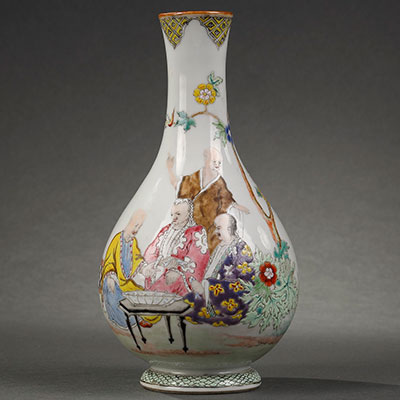An important Imari porcelain baluster jar decorated with charactersamong clouds
- Imari porcelain
Description
The vase is a baluster jar of big size: short cylindrical neck, high and rounded shoulder with a large body. The jar is painted with overglaze enamels from the Imari palette (black, green, eggplant, yellow and iron red), underglaze cobalt blue and with numerous gold highlights. Big iron red and gold clouds alternating with chrysanthemums scrolls divide the decoration in three large parts. The neck with dragons chasing the pearl among gilt clouds. The slightly convex base is also glazed.
The characters depicted on this jar are from a famous Noh play called « Takasago ». During a journey in Harima district, the priest of the Aso sanctuary came to Takasago to see famous landscapes. He meets Jo and Uba, an old couple, who are the spirits of the famous pines of Takasago and Sumiyoshi (they are considered as spouses in the Japanese tradition). The next part takes place in Sumiyoshi sanctuary where Jo makes a sacred dance to honour the gods. Jo and Uba are the incarnation of long life and marital bliss.
Japanese craftsmen discovered the secret of porcelain making at the beginning of 17th century, when a kaolin deposit was found in Arita. The wars in China at the end of Ming dynasty destroyed many kilns and stopped the porcelain ware exports. Japanese potters created at this time the Imari decoration, whose was named after the harbour from where the porcelains were exported.
An important Imari porcelain baluster jar decorated with charactersamong clouds
- Imari porcelain
Discover more Porcelain
Return to the collection


Famille rose porcelain vase decorated with the “4 Doctors” after Cornelis Pronk


A pair of biscuit turquoise-glazed bitong brushpots


A pair of porcelain Putai figures


A pair of small rouleau vases decorated with birds flying among flowers




















